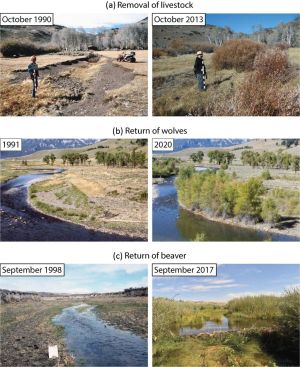Rewilding: Difference between revisions
Florez4747 (talk | contribs) |
Florez4747 (talk | contribs) |
||
| Line 6: | Line 6: | ||
= Forests = | = Forests = | ||
https://www.sciencedirect.com/science/article/abs/pii/S1389934119301844 | |||
= Wolves and Beavers = | = Wolves and Beavers = | ||
Revision as of 20:46, 23 May 2023
Rewilding is the process of allowing ecosystems to return to a more natural state specifically with their original native plants, animals, microorganisms etc.
Grasslands
Forests
https://www.sciencedirect.com/science/article/abs/pii/S1389934119301844
Wolves and Beavers
In a paper published today in BioScience, “Rewilding the American West,” authors from CU Boulder, Oregon State University and several other institutions suggest using nearly 193,000 square miles (500,000 square kilometers) of federal lands in 11 states to establish a contiguous network based on potential habitat for the gray wolf and American beaver. Supporting those species through management changes on federal land would help control elk populations, support tree growth, boost biodiversity, improve water quality, increase carbon sequestration and restore riparian habitats, they said.[1]
Bison
Letting Bison return to the grasslands of the Great Plains has been shown to be a highly effective way to restore depleted and devastated lands. A nearly three decade study[2] was conducted at the ‘Konza Prairie Biological’ (KPBS) in Central Kansas comparing vegetation among sites with Bison, Cattle, and a control group with neither animals present. The results indicate a substantial 86% to 103% increase of native plants species richness and cattle had modest increases around 30% to 41% increase. Sites with Bison were also more resilient to extreme drought, increasing species richness post-drought whereas Cattle sites resulted in no net change at the end of the study.
Western Rewilding Network
"The Western Rewilding Network currently includes 92 threatened and endangered species across nine taxonomic groups: five amphibians, five birds, two crustaceans, 22 fishes, 39 flowering plants, five insects, 11 mammals, one reptile, and two snail species. The reserves with the greatest numbers of threatened and endangered species were the Mogollon Plateau and the Southern Rockies. Overall, livestock grazing poses by far the most common threat, followed by mining, logging and oil and gas drilling. In 7 of the 11 potential reserves, at least half of the listed species are threatened by livestock grazing. In all of the 11 potential reserves, average stream densities exceed 50 meters per km2, suggesting significant opportunities for high density beaver restoration."[3]
